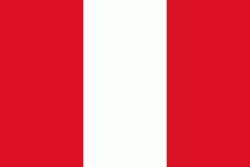Mariscal Luzuriaga Province (Provincia de Mariscal Luzuriaga)
Since the Inca roads crossed its territory up to the Ecuador, where its capital Piscobamba is located now, there was a strategic tambo during the Inca's time. Pisqu Pampa means "bird plain" in Quechua. This place has a special attraction due to four mythical hills: Kampanayuq, Aswaq, Amañico and Wankash. Bloody battles were performed here by the armies of the Inca Tupac Yupanqui and the conchucos, piscopampas and huaras. See Garcilaso: "Comentarios reales".
One of the highest peaks of the province is Tuqtupampa at approximately 5240 m. Other mountains are listed below:
• Allqu Maqasqa
• Anta Hirka
• Ch'aki Qucha
• Milla Hirka
• Muru Qucha
• Puka Hirka
• Pukarahu
Map - Mariscal Luzuriaga Province (Provincia de Mariscal Luzuriaga)
Map
Country - Peru
 |
 |
| Flag of Peru | |
Peruvian territory was home to several cultures during the ancient and medieval periods, and has one of the longest histories of civilization of any country, tracing its heritage back to the 10th millennium BCE. Notable pre-colonial cultures and civilizations include the Caral-Supe civilization (the earliest civilization in the Americas and considered one of the cradles of civilization), the Nazca culture, the Wari and Tiwanaku empires, the Kingdom of Cusco, and the Inca Empire, the largest known state in the pre-Columbian Americas.
Currency / Language
| ISO | Currency | Symbol | Significant figures |
|---|---|---|---|
| PEN | Peruvian sol | S/ | 2 |
| ISO | Language |
|---|---|
| AY | Aymara language |
| QU | Quechua language |
| ES | Spanish language |















